Garden Fence Ideas: Transform Your Outdoor Space with Inspiring Designs for 2025
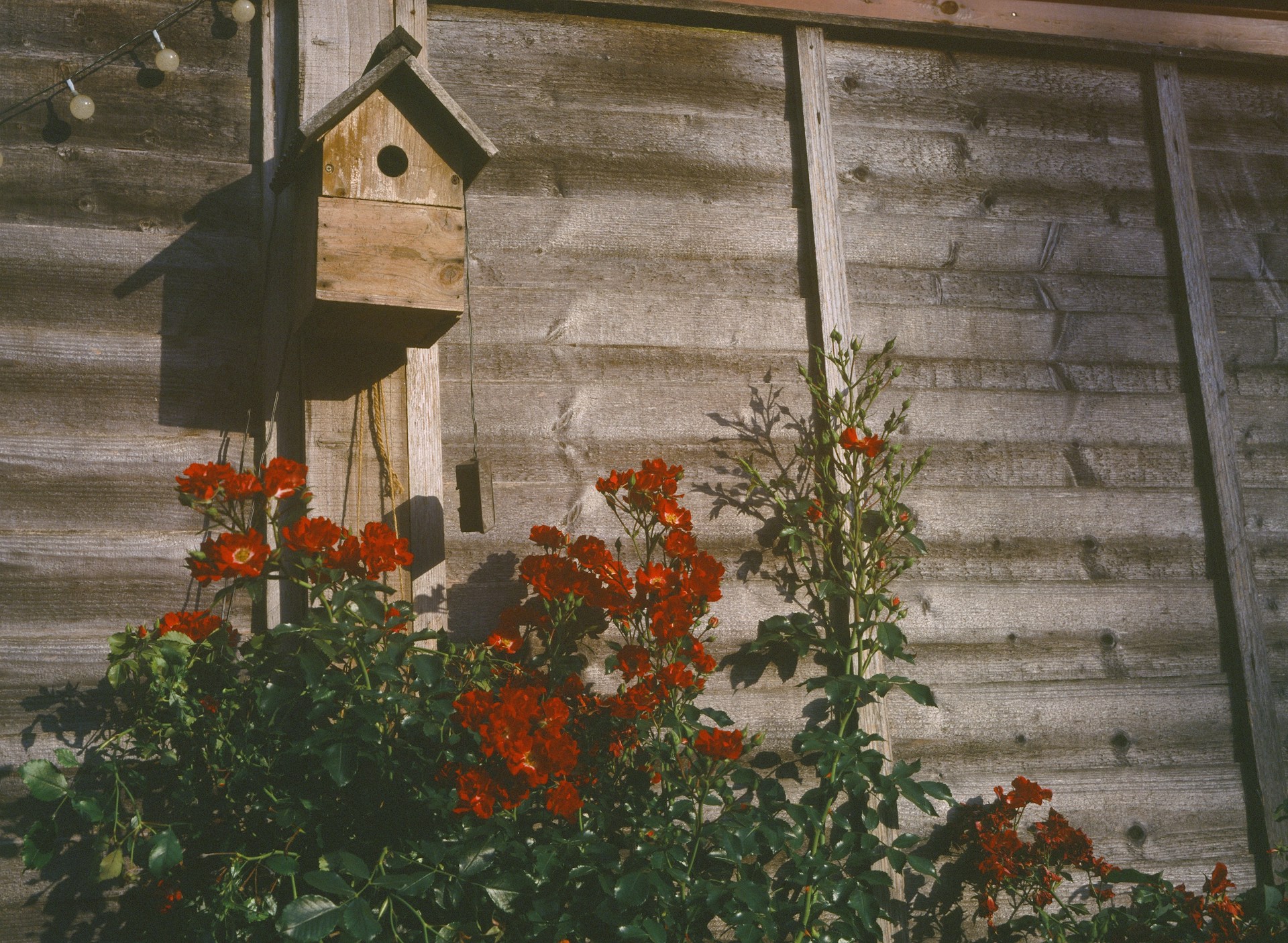
Your garden fence does more than mark property boundaries—it defines your outdoor space's character, provides privacy and security, and can dramatically enhance your home's kerb appeal. Whether you're planning a complete garden makeover or simply refreshing tired fencing, choosing the right fence style, material, and design transforms how you experience and enjoy your garden.
From classic wooden picket fences to contemporary metal designs, the options for garden fencing have never been more diverse. Understanding the different styles, materials, and practical considerations helps you select fencing that perfectly balances aesthetics, functionality, and budget. This comprehensive guide explores inspiring garden fence ideas for every style of home and garden, from compact urban spaces to expansive rural properties.
Understanding Garden Fence Styles and Your Options
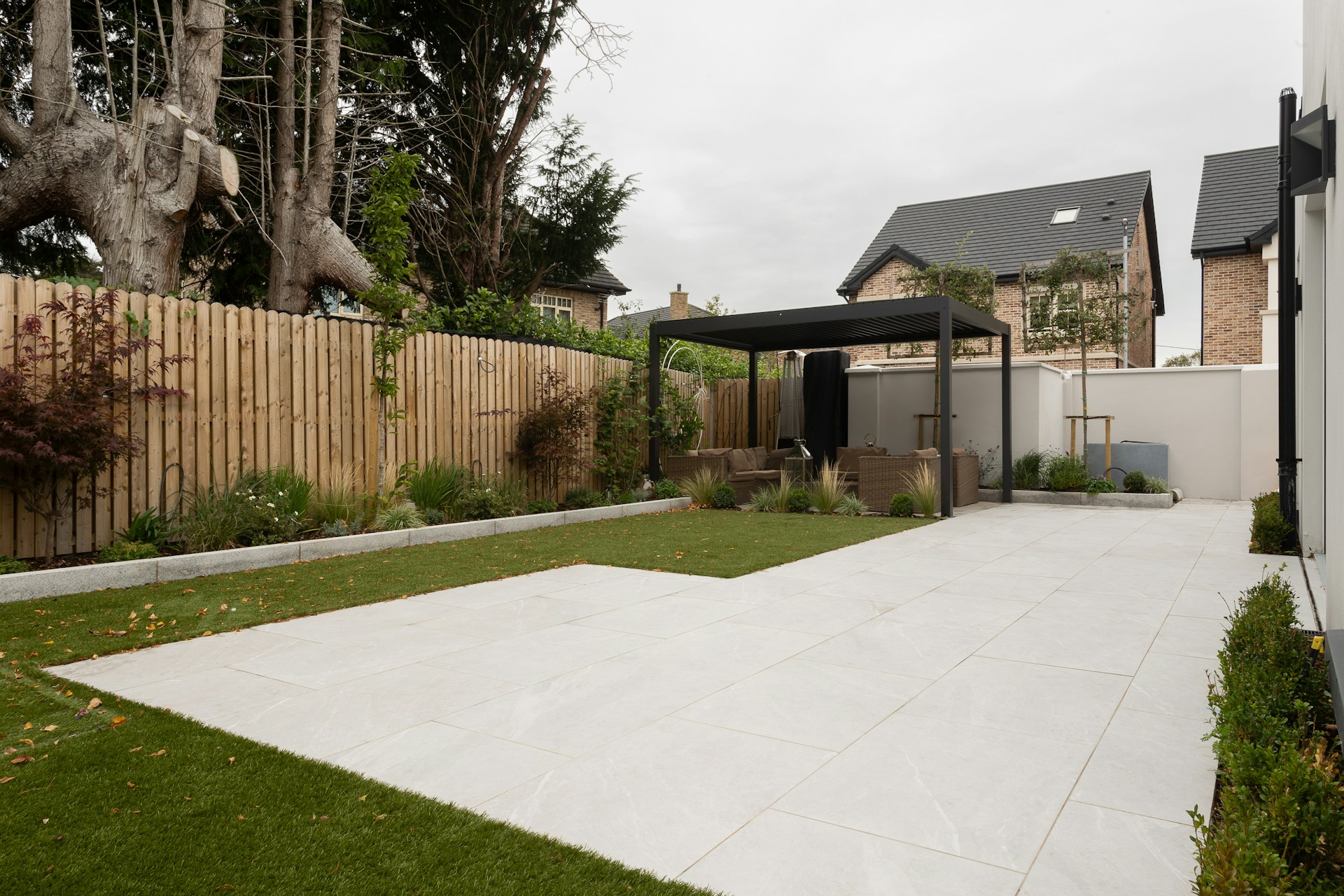
Garden fencing serves multiple purposes, from defining boundaries and providing privacy to enhancing security and adding decorative appeal. Understanding the different styles available helps you identify options that meet your practical needs while complementing your property's architecture and garden design.
Traditional Fencing Styles
Traditional garden fences have endured for decades because they offer timeless appeal and proven functionality. Picket fences remain one of the most popular choices for front gardens, featuring evenly spaced vertical boards attached to horizontal rails. These charming fences typically stand 90cm to 120cm tall, making them ideal for marking boundaries without blocking views or light. Picket fences work beautifully with cottage-style homes, Victorian properties, and country gardens.
Close board fencing, also called feather edge fencing, provides maximum privacy through overlapping vertical boards attached to horizontal rails. This robust style typically stands 180cm tall, offering complete privacy and security for back gardens. The overlapping construction creates a solid barrier against wind while the natural wood grain adds warmth and character.
Panel fencing represents the most common garden fencing in the UK, offering an economical solution that's quick to install. Standard fence panels typically measure 183cm wide by 180cm tall, creating complete privacy screens. Available in various styles from traditional lap panels to contemporary slatted designs, panel fencing suits most garden styles and budgets.
Contemporary Fencing Designs
Modern garden fencing embraces clean lines, innovative materials, and architectural design principles. Horizontal board fencing creates striking contemporary appeal through horizontal rather than vertical board placement. This style works particularly well with modern architecture, creating visual width that makes gardens appear larger.
Slatted fencing with spacing between boards offers a lighter, more open feel than solid panels while still providing partial privacy. This design allows air circulation and filtered light, making it ideal for smaller gardens where solid fencing might feel oppressive. The spacing can be customized to balance privacy with openness.
Mixed material fencing combines different materials like wood and metal, or composite and steel, creating unique contemporary designs. These combinations often pair natural wood warmth with industrial metal accents, producing fencing that serves as garden focal points rather than simple boundaries.
Specialty Fencing Options
Trellis fencing provides decorative screening while supporting climbing plants. Available in diamond or square lattice patterns, trellis can be used alone for lightweight boundary marking or topped onto solid fencing to add height and interest. It's particularly effective for creating romantic cottage garden aesthetics.
Living fences using hedging plants offer natural alternatives to constructed fencing. While requiring more maintenance and time to establish, hedges provide habitat for wildlife, improve air quality, and create softly undulating boundaries. Common choices include privet, beech, hornbeam, and yew.
Bamboo screening provides exotic appeal with sustainable credentials. Real bamboo panels or bamboo-effect screening creates zen garden atmospheres while offering good privacy. The natural material weathers to attractive silver-grey tones, though regular treatment maintains the golden-brown colour.
Choosing the Right Materials for Your Garden Fence
Material selection significantly impacts your fence's appearance, longevity, maintenance requirements, and cost. Understanding the characteristics of different fencing materials helps you make informed decisions balancing practical and aesthetic considerations. Understanding fence installation costs helps you budget accurately for your chosen design and material combination.
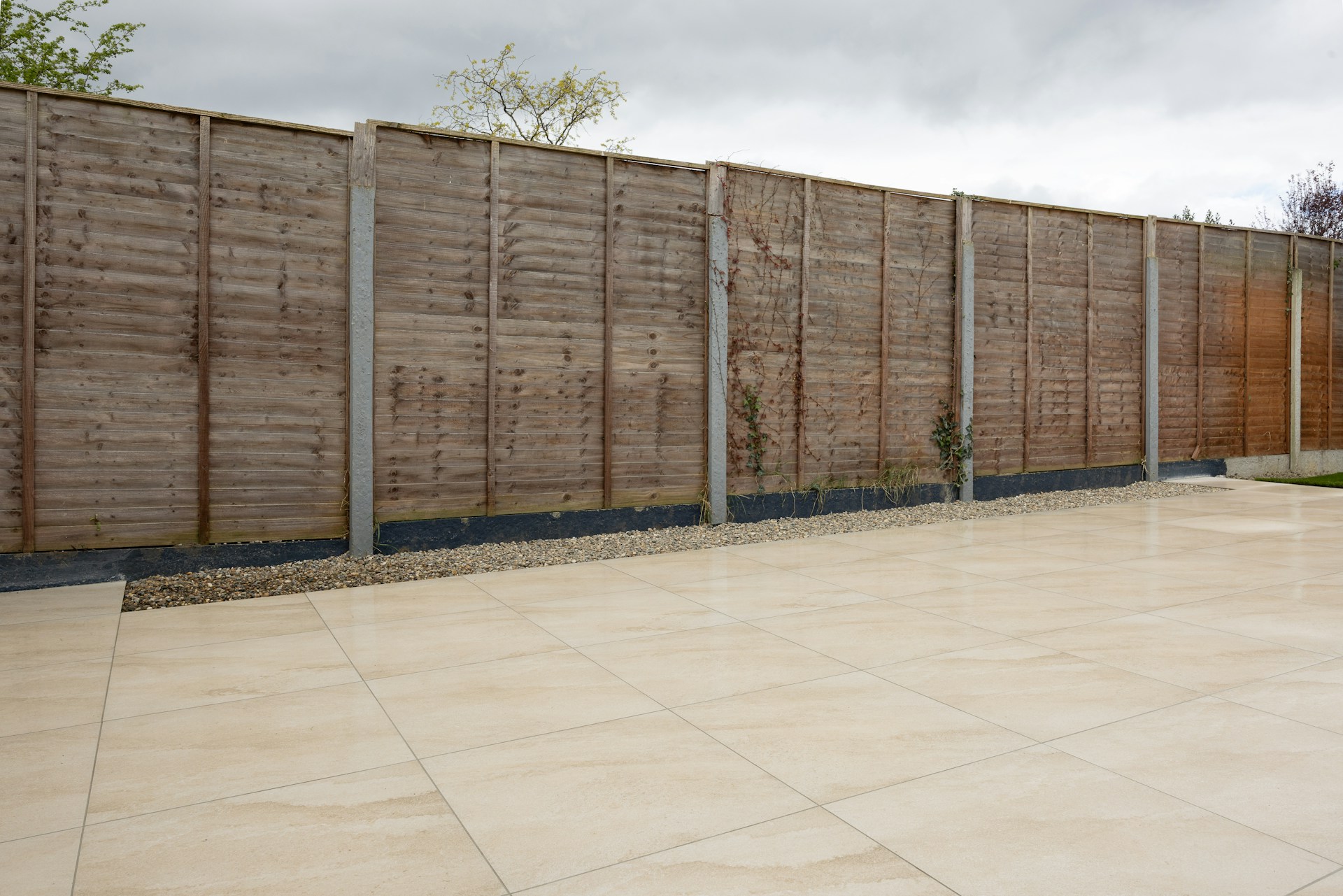
Wooden Garden Fencing: Classic and Versatile
Wood remains the most popular garden fencing material in the UK, offering natural beauty, versatility, and relatively affordable pricing. Different wood types provide varying levels of durability, appearance, and cost.
Pressure-Treated Softwood
Pressure-treated softwood, typically pine or spruce, represents the most economical wooden fencing option. The pressure treatment process forces preservatives deep into the wood, protecting against rot, fungal decay, and insect damage. Quality treated softwood should last 15-20 years with basic maintenance.
Treated softwood typically appears green immediately after treatment due to copper-based preservatives. This colour fades to honey-brown within months, then gradually weathers to silver-grey without further treatment. Many homeowners prefer to apply wood stain or paint after the initial weathering period to maintain their preferred colour.
Standard fence panels from retailers like B&Q and Screwfix typically use pressure-treated softwood. These panels offer excellent value, with 6-foot panels often costing £25-£45 depending on style and quality. The trade-off for lower cost is generally shorter lifespan compared to premium hardwoods.
Cedar and Other Durable Softwoods
Western Red Cedar offers superior natural durability compared to treated pine, containing natural oils that resist rot, decay, and insect damage without chemical treatment. Cedar's beautiful reddish-brown colour and pleasant aroma make it a premium choice for garden fencing.
Cedar weathers naturally to attractive silver-grey tones or can be maintained at its original colour with annual oiling. While more expensive than pressure-treated softwood—typically 50-100% higher cost—cedar's 20–30-year lifespan and minimal maintenance requirements often justify the investment.
The sustainability credentials of cedar vary depending on source, so look for FSC-certified options. According to the Forest Stewardship Council, FSC certification ensures wood comes from responsibly managed forests that provide environmental, social, and economic benefits.
Hardwood Garden Fencing
Hardwoods like oak, sweet chestnut, and tropical hardwoods offer exceptional durability and distinctive appearance. Oak fencing can last 25-40 years or more, developing rich character as it weathers. The natural tannins in oak provide excellent rot resistance without chemical treatment.
Sweet chestnut shares similar durability to oak but typically costs 20-30% less, making it an excellent compromise between softwood and premium hardwoods. Both oak and sweet chestnut support sustainable British forestry when sourced domestically.
Tropical hardwoods like iroko and teak offer exceptional durability—often 40+ years—but raise sustainability concerns. Always verify FSC certification for tropical hardwoods to ensure responsible sourcing. The Timber Trade Federation provides guidance on sustainable timber sourcing.
Metal Garden Fencing: Modern and Low-Maintenance
Metal fencing offers contemporary aesthetics, exceptional durability, and minimal maintenance requirements, though typically at higher initial costs than wooden alternatives.
Steel and Wrought Iron
Steel fencing provides strong, secure boundaries with elegant designs ranging from simple horizontal bars to ornate decorative patterns. Galvanized steel offers excellent rust resistance, while powder-coated finishes provide colour options and additional weather protection.
Wrought iron fencing, while expensive, creates stunning traditional designs perfect for period properties and formal gardens. Modern "wrought iron" fencing typically uses mild steel formed to replicate traditional forged iron aesthetics at more accessible prices.
Steel fencing requires minimal maintenance beyond occasional washing and inspection for rust damage, particularly on cut edges or damaged coating areas. Quality steel fencing should last 30-50 years with basic care.
Aluminium Fencing
Aluminium offers similar aesthetics to steel without rust concerns, making it ideal for coastal areas or damp climates. Powder-coated aluminium fencing requires virtually no maintenance beyond occasional cleaning, and the material won't rot, warp, or deteriorate like wood.
The main drawback of aluminium fencing is lower strength compared to steel, making it less suitable for high-security applications. However, for standard residential boundaries, aluminium provides excellent durability and appearance. Expect to pay 30-50% more than equivalent wooden fencing initially, offset by virtually zero maintenance costs over decades.
Metal Panel and Corten Steel
Laser-cut metal panels create striking contemporary boundaries featuring decorative patterns, geometric designs, or nature-inspired motifs. These panels combine privacy screening with artistic expression, serving as garden focal points.
Corten steel, also called weathering steel, develops a stable rust-like patina that protects against further corrosion. This distinctive orange-brown appearance suits contemporary gardens and provides unique character. The patina stabilizes within months, requiring no maintenance while lasting 50+ years.
Composite and Alternative Materials
Composite fencing combines wood fibers with recycled plastics, creating materials that replicate wood appearance without maintenance requirements. These products won't rot, warp, or require painting, though they cost 50-100% more than wooden equivalents initially.
High-quality composites should last 25-30 years with virtually no maintenance beyond occasional washing. Colours remain stable without fading, though darker colours may show scratches more readily than lighter tones. The environmental credentials of composites vary—look for products using high percentages of recycled materials.
Vinyl and PVC fencing offers another low-maintenance alternative, particularly popular in North America but increasingly available in the UK. These synthetic materials resist weather, insects, and decay while never requiring painting. However, vinyl can become brittle in extreme cold and may not suit all garden styles aesthetically.
Wooden Garden Fence Ideas: Traditional Charm with Modern Touches
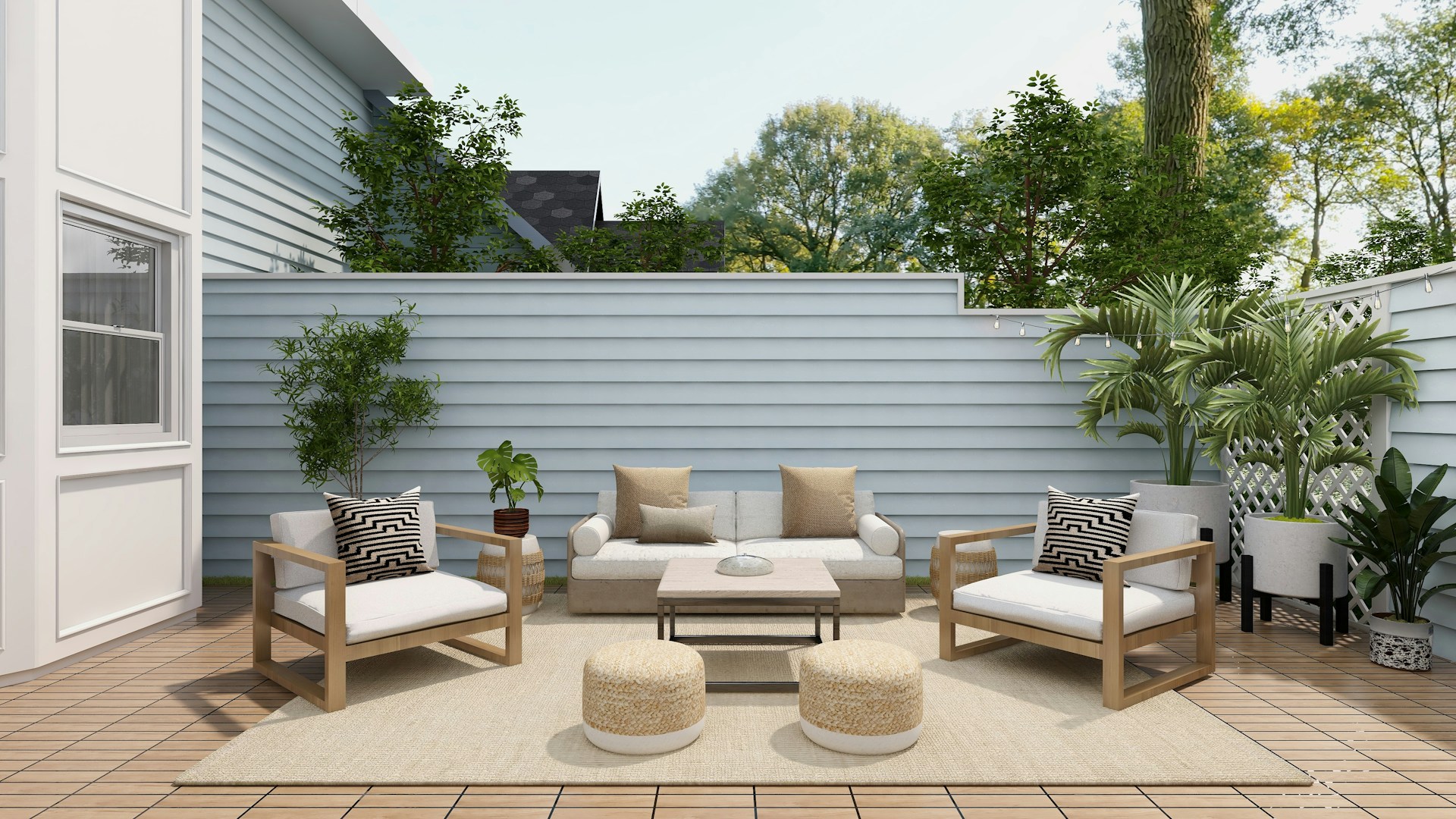
Wooden fencing remains the most popular choice for UK gardens, offering warmth, versatility, and the ability to customize through stains, paints, or natural weathering. These ideas showcase how wooden fencing can suit diverse garden styles from cottage gardens to contemporary outdoor spaces.
1. Classic Picket Fence for Front Gardens
White-painted picket fencing creates quintessential cottage garden charm perfect for front boundaries. The open design maintains neighbourhood visibility while defining property lines and supporting climbing roses or honeysuckle. Paint requires reapplication every 3-4 years, but the timeless appeal makes maintenance worthwhile.
Modern interpretations of picket fencing use horizontal rather than vertical pickets for contemporary twist or vary picket heights to create wave patterns. Staining pickets in sage green, navy, or charcoal creates more distinctive looks than traditional white while reducing visible wear between maintenance cycles.
2. Horizontal Board Fencing
Contemporary horizontal board fencing creates striking modern boundaries through boards running horizontally rather than vertically. This design makes gardens appear wider, a valuable optical trick in narrow urban spaces. Using boards of varying widths adds visual interest while maintaining clean lines.
The horizontal orientation provides excellent privacy when boards are closely spaced or creates semi-private screening with wider spacing allowing filtered views and light. Cedar works beautifully for this application, developing attractive silver patina, or can be oiled annually to maintain warm honey tones.
3. Close Board Fencing with Decorative Tops
Traditional close board fencing gains contemporary appeal through decorative top treatments. Cutting boards to different heights creates undulating wave patterns, while angled cuts produce geometric zigzags. These design details transform standard privacy fencing into architectural features.
Adding trellis toppers to close board fencing increases height for privacy while maintaining light flow. The combination creates defined lower privacy with lighter upper screening, and supports climbing plants that soften hard edges. Consider pressure-treated trellis for durability, painted or stained to complement the fencing.
4. Slatted Fencing with Spacing
Spaced slat fencing balances privacy with openness, ideal for smaller gardens where solid fencing might feel claustrophobic. Vertical or horizontal slats with 2-3cm gaps provide substantial privacy while allowing air circulation and filtered light.
This style works particularly well painted in dark colours like charcoal or black, which recede visually to make gardens appear larger. The spacing also reduces wind resistance compared to solid fencing, making slatted designs suitable for exposed sites.
5. Mixed-Height Timber Fencing
Varying fence heights across your boundary creates visual interest and accommodates different privacy needs. Lower fencing in front gardens maintains street visibility while higher panels in back gardens ensure complete privacy. Stepped transitions between heights look more intentional than abrupt changes.
This approach works well on sloping sites, where stepped panels accommodate gradient changes more aesthetically than a single sloping fence line. Each panel remains level with its posts, creating a terraced effect that looks purposeful rather than compromised.
Modern Garden Fencing Ideas for Contemporary Homes
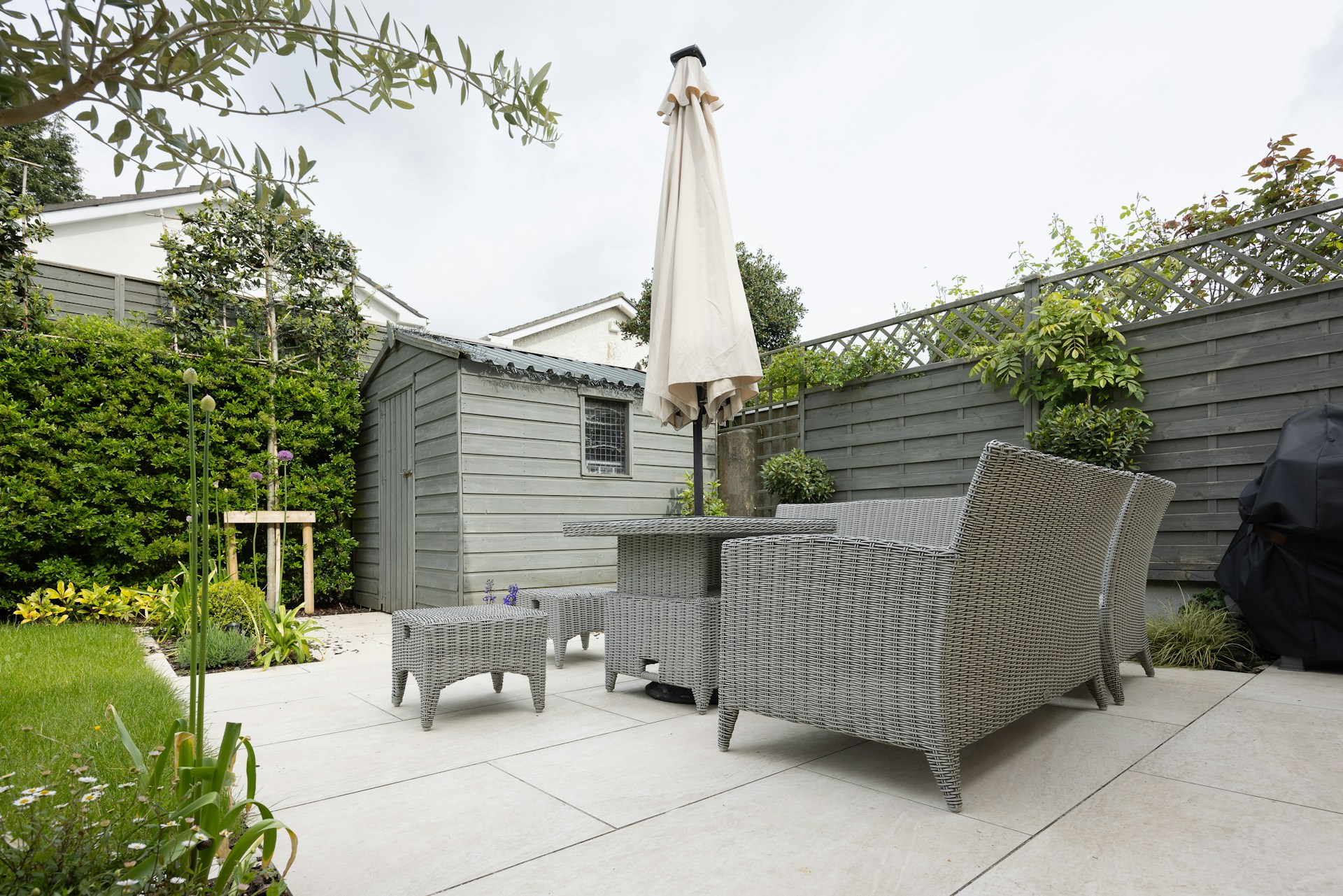
Contemporary garden fencing embraces minimalist design principles, innovative materials, and architectural aesthetics that complement modern homes while creating stunning outdoor spaces.
1. Black Painted Horizontal Slat Fencing
Black horizontal slat fencing creates bold contemporary statements that make gardens appear larger through strong horizontal lines and receding dark colour. The clean lines suit modern architecture while providing excellent privacy when slats are closely spaced.
Using sustainably sourced timber painted with exterior-grade black paint provides the look at accessible cost. For lower maintenance, consider composite boards in black or anthracite grey that never require repainting. The darker tones beautifully highlight colourful planting, making flowers and foliage appear more vibrant.
2. Living Wall Combined with Fencing
Integrating vertical planters into fence structures creates living walls that blur boundaries between fencing and garden. This approach works beautifully with horizontal board fencing, with planter boxes attached between board sections.
The planting softens hard fencing lines while the structure provides privacy and definition. Choose evergreen plants for year-round interest or mix seasonal colour for changing displays. This design particularly suits urban gardens, adding valuable planting space in compact areas while serving as attractive privacy screening.
3. Laser-Cut Metal Panel Screening
Decorative laser-cut metal panels create stunning contemporary boundaries that function as garden art. Geometric patterns, nature-inspired designs, or abstract motifs provide privacy while adding visual interest. These panels work well alone or combined with wood framing.
Position laser-cut panels to catch low sunlight for dramatic shadow displays or backlight them for evening drama. While more expensive than standard fencing—often £200-£500 per panel—the artistic impact justifies the investment in smaller spaces where panels serve as focal points.
4. Corten Steel Edging and Fencing
Corten weathering steel develops distinctive rust-orange patina that contrasts beautifully with green planting and modern architecture. Use as low edging to define garden zones, or full-height panels for privacy screening with industrial-chic appeal.
The material requires no maintenance once the stable patina forms, typically within 3-6 months of installation. However, note that runoff during initial weathering can stain adjacent paving, so consider this when planning installation near patios or paths.
5. Glass Panel Inserts with Timber Frames
Combining timber framing with clear or frosted glass panels creates contemporary fencing that maintains light flow while providing privacy. This works particularly well for balcony railings or rooftop terraces were preserving views matters.
Toughened safety glass costs significantly more than standard fencing—approximately £150-£300 per linear meter—but creates stunning modern aesthetics. Frosted or textured glass provides privacy while maintaining luminosity, ideal for compact urban gardens where solid fencing would feel oppressive.
Small Garden Fence Ideas: Maximizing Space and Style
Small gardens benefit from carefully chosen fencing that provides privacy and definition without overwhelming limited space. These ideas help create boundaries that enhance rather than dominate compact outdoor areas.
1. Lower Front Fencing with Trellis Toppers
For small front gardens, low fencing (90-120cm) maintains openness and light while defining boundaries. Adding trellis toppers increases privacy without creating solid barriers that make small spaces feel cramped.
Paint lower sections and trellis in matching colours for cohesive look or use contrasting tones to add visual interest. Train climbing plants up trellis sections for natural screening that softens the structure. This combination provides the best of both worlds—defined boundaries with airy appeal.
2. Painted Feature Fencing
In very small gardens, fencing provides valuable opportunities for colour and interest. Paint fences in light colours like white, cream, or pale grey to reflect light and make spaces appear larger. Alternatively, create dramatic backdrops with deep colours like navy, forest green, or charcoal that make planting pop.
Consider painting different fence sections in complementary colours to create zones in small gardens, making the space feel more complex and interesting than single-color treatment. Vertical stripes painted onto fencing can make small gardens appear taller, while horizontal stripes create width illusion.
3. Mirror Panels for Illusion of Space
Installing garden mirrors on fencing creates powerful illusions of depth in tiny spaces. Position mirrors to reflect attractive planting or garden features, effectively doubling your garden's perceived size.
Use purpose-made acrylic garden mirrors rather than glass for safety and weather resistance. Frame mirrors with timber or position them to look like windows or arched doorways for maximum illusory effect. This technique works particularly well in narrow side passages or tiny courtyard gardens.
4. Slim-Profile Vertical Planters
Maximize planting space in small gardens by attaching slim planters to fencing. Vertical planting adds depth and interest without consuming valuable ground space. Use trailing plants in upper planters to create cascading green walls.
Choose planters in colours that complement your fence colour—natural wood planters suit timber fencing, while metal planters complement contemporary designs. Ensure planters have drainage holes and fence fixings are secure, as planted containers become heavy.
5. Open Slatted Designs
In small gardens, avoid solid fencing that creates a boxed-in feeling. Instead, choose slatted designs with spacing that allows glimpses through while maintaining privacy. The partially open design permits air circulation and light penetration without compromising boundary definition.
Paint slatted fencing in dark colours to create see-through effect where the fence visually recedes, making gardens appear more spacious. This works particularly well with contemporary garden designs where clean lines and spacious feeling matter more than complete privacy.
Front Garden Fence Ideas: Enhancing Kerb Appeal
Front garden fencing makes powerful first impressions, setting the tone for your entire property. These ideas balance privacy, security, and aesthetics to enhance kerb appeal while complementing your home's architecture.
1. Traditional Picket Fence with Pillared Entry
Classic white picket fencing creates timeless appeal perfect for period properties. Add substantial brick or stone pillars at the gateway for traditional elegance. The pillars provide structural strength while creating a formal entrance that elevates simple picket fencing.
Install automated gates between pillars for convenient access without compromising the traditional aesthetic. Match pillar materials to your house for cohesive design—brick pillars for brick houses, rendered pillars for rendered properties. Understanding garden gate costs helps you budget for quality gates that complement your fence design and enhance your property's entrance.
2. Low Wall with Railings
Combining low brick or stone walls (60-90cm) with metal railings creates formal traditional boundaries suited to Victorian and Edwardian properties. The wall provides solid lower screening while railings maintain visibility and light.
Match railing style to your property's period—ornate wrought iron for Victorian homes, simpler geometric designs for Art Deco properties. Paint railings in traditional black, or modern dark grey for contemporary twist on classic design.
3. Contemporary Horizontal Slat Fencing
Modern homes pair beautifully with horizontal slat fencing in natural timber or painted finishes. Keep front garden fencing lower than back garden (120-150cm) to avoid creating fortress-like appearance while maintaining privacy from street.
Add lighting integrated into fence posts for attractive evening kerb appeal and improved security. LED strip lighting running along horizontal slats creates stunning contemporary feature visible from street at night.
4. Rendered Block Walls with Planting
Rendered concrete block walls painted white or light grey create clean contemporary boundaries for modern properties. While more expensive than fencing, walls require virtually no maintenance and last indefinitely.
Soften hard wall lines with planting pockets left during construction, or wall-mounted planters added after. Train climbers across wall sections to add green interest to what might otherwise appear stark. This approach suits minimalist contemporary architecture particularly well.
5. Mixed Material Boundaries
Combining different materials creates distinctive front boundaries with visual interest. Consider brick piers with timber panels between, stone walls with decorative metal inserts, or rendered walls with glass panel sections.
The mixed approach allows you to incorporate materials that match your house while adding contemporary touches. Ensure materials are proportioned well—substantial piers support lighter infill panels, while heavier materials need adequate structural support.
Back Garden Fence Ideas: Privacy and Comfort
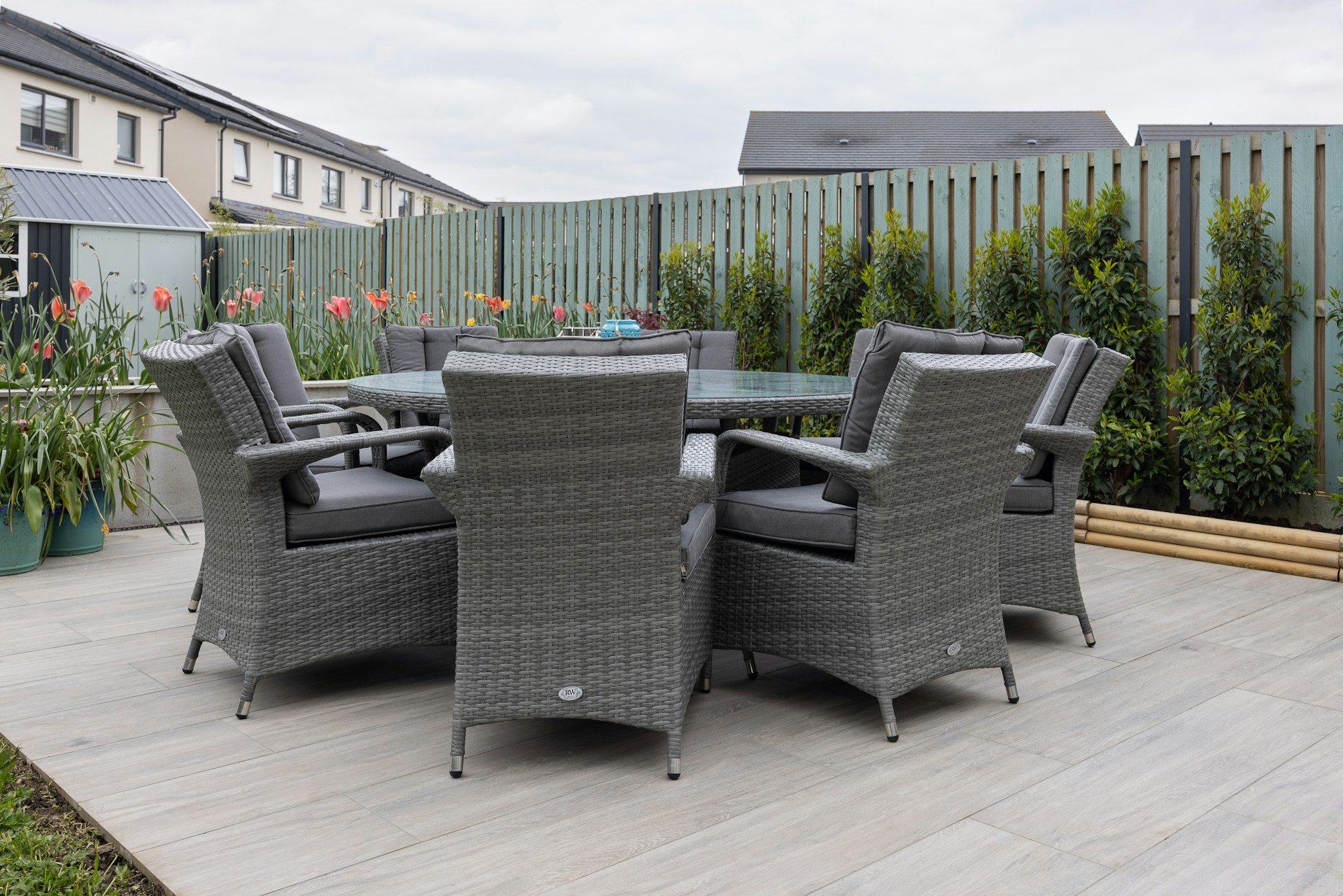
Back garden fencing prioritizes privacy, security, and creating comfortable outdoor living spaces. These ideas transform basic boundaries into features that enhance how you use and enjoy your back garden.
1. Tall Close Board Fencing with Integrated Screening
Standard 180cm close board fencing provides excellent privacy, but adding trellis toppers increases height to 210-240cm for complete seclusion. The trellis maintains light flow while supporting climbing plants that soften the boundary.
Choose trellis with 10-15cm spacing to balance privacy with light. Paint or stain trellis to match lower fencing or use contrasting colours to define the different sections. Train evergreen climbers like ivy or star jasmine for year-round screening, or deciduous options like roses or clematis for seasonal interest.
2. Living Privacy Screens with Hedge Combinations
Combine fencing with hedging to create naturalistic boundaries that provide habitat and seasonal interest. Install fencing first for immediate privacy, then plant hedging in front. As hedging matures, it takes over primary screening role while fencing provides structure and support.
Good hedge choices include photinia 'Red Robin' for colourful evergreen screening, Portuguese laurel for formal appearance, or native mixed hedging including hawthorn, blackthorn, and field maple for wildlife value. The Woodland Trust provides excellent guidance on native hedge planting and maintenance.
3. Bamboo Screening for Zen Gardens
Natural bamboo screening creates exotic zen garden atmosphere with excellent privacy. Real bamboo panels develop attractive weathered patina, while synthetic bamboo-effect screening offers similar look with potentially longer lifespan.
Roll-out bamboo screening provides economical option for covering existing chain link or unsightly fencing. Secure it firmly to prevent wind damage and consider bamboo's 5-7 year typical lifespan when budgeting. For longer-lasting alternatives, consider composite bamboo-effect fencing.
4. Painted Feature Walls for Outdoor Rooms
Transform back garden fencing into outdoor room "walls" through bold paint colours that complement your outdoor living space. Deep blues and greens create calm backdrops for dining areas, while warm terracotta’s and ochres suit Mediterranean planting schemes.
Consider painting different fence sections in coordinating colours to define different garden zones—one colour for dining area, another for planting zones, a third for play spaces. This approach works particularly well in larger gardens where defining distinct areas enhances functionality.
5. Integrated Seating and Storage
Maximize back garden functionality by building storage benches against fencing. These dual-purpose structures provide seating for entertaining while concealing garden equipment, cushions, or children's toys.
Build benches from pressure-treated timber painted to match or complement fencing colours. Add cushions for comfort and incorporate planting either side to integrate benches into the garden design. This approach works particularly well in compact gardens where every element must serve multiple purposes.
Planning Permission and Legal Considerations
Before installing or replacing garden fencing, understanding legal requirements prevents costly mistakes and potential disputes with neighbours or planning authorities.
Planning Permission Requirements
Most garden fencing doesn't require planning permission under permitted development rights. However, restrictions apply in specific circumstances. According to the Planning Portal, you may need planning permission if:
Your fence exceeds 2 meters in height, or 1 meter if adjacent to a highway used by vehicles or the curtilage of a dwelling. Properties in conservation areas, Areas of Outstanding Natural Beauty, National Parks, or World Heritage Sites face additional restrictions even for fences under 2 meters. Listed buildings require listed building consent for any alterations including fencing.
Boundary Responsibilities and Neighbour Considerations
Determining boundary ownership before fence installation prevents disputes. Property deeds typically indicate ownership through "T" marks on boundary lines—the side with the T mark indicates ownership. If deeds don't clearly show ownership, boundaries may be party boundaries with shared responsibility.
Even when you own the boundary, consulting neighbours before major fencing changes demonstrates courtesy and can prevent disputes. The fence traditionally shows its "good side" (no posts or rails visible) to neighbours, though this convention isn't legally required.
The Party Wall Act 1996 may apply if your fence sits on or straddles a boundary line shared with neighbours. Consult the government's party wall guidance for detailed requirements.
Height Restrictions and Safety
Building Regulations generally don't apply to garden fencing unless it exceeds certain heights or connects to buildings. However, safety considerations matter regardless of regulations. Ensure fence posts are adequately sized and deeply embedded—typically 60cm minimum for standard 180cm fencing.
Gates must open into your property rather than onto public highways or pavements, preventing obstruction or safety hazards. Self-closing mechanisms may be required for gates providing pool access, and any fencing around pools should meet specific height and gap requirements to prevent child access.
Finding Professional Fencers for Your Project
While some garden fencing projects suit DIY approaches, professional installation ensures quality results, particularly for complex designs or extensive boundaries.
When to Hire Professional Fencers
Professional installation makes sense for extensive fencing requiring multiple posts and panels, particularly when ground conditions complicate post installation. Sites with rocky soil, heavy clay, or variable terrain benefit from professional equipment and expertise.
Complex designs including gates, curves, slopes, or mixed materials justify professional installation. Fencers have specialized tools and experience with challenging installations that would frustrate DIY attempts.
Time considerations favour professional installation when you need fencing completed quickly for security, privacy, or before planned events. What might take homeowners several weekends can be completed by professionals in days.
What to Look for in Fencing Contractors
Quality fencing contractors should provide detailed written quotations specifying materials, dimensions, labour costs, and completion timelines. Clear quotes prevent misunderstandings and allow accurate price comparisons between contractors.
Ask about warranties covering both materials and labour. Reputable contractors typically guarantee their work for 12 months minimum, with materials warranties varying by product. Pressure-treated timber should carry 15-year guarantees against rot and insect damage.
Check whether contractors handle waste disposal, as old fencing removal can represent substantial volume. Some contractors include disposal in quotations, while others charge separately or expect homeowners to arrange disposal.
Getting Multiple Quotes
Request quotes from at least three fencing contractors to ensure competitive pricing and compare approaches. Provide identical specifications to each contractor so quotes are directly comparable.
Be wary of quotes significantly below market rates, which may indicate corner-cutting on materials quality, post depth, or workmanship. Similarly suspicious are quotes dramatically above average unless justified by premium materials or complex site conditions.
FixaTrader simplifies finding reliable fencing contractors by connecting you with vetted professionals in your area. Our platform allows you to describe your fencing project, receive quotes from multiple local fencers, compare pricing and customer reviews, and book with confidence knowing you're working with verified professionals. Reviewing detailed fence installation costs helps you understand what constitutes fair pricing for professional work before comparing contractor quotes.